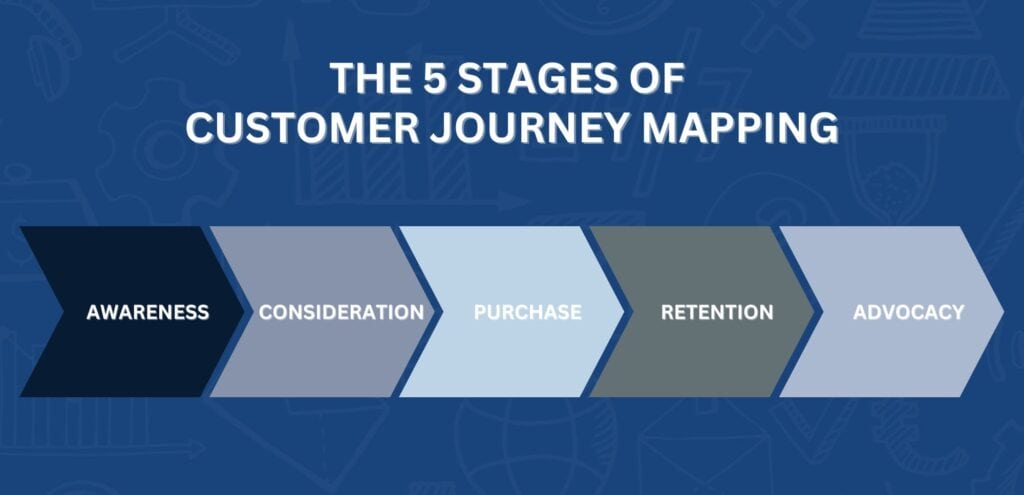Are you ready to take your business to the next level of success? Do you need innovative solutions to grow your customer base and give you a needed competitive edge over your competitors? Customer journey mapping could provide a vital key to unlock organizational transformation.
Journey maps can lend to understanding and enhancing customer experiences in a way that allows your company to build long-lasting, loyal relationships and measurable revenue growth. Journey mapping is simple to incorporate into your business strategies, and may revolutionize the customer experience.
Let’s explore the ins and outs of customer journey mapping, and how it can help you to develop a thorough understanding of customer experiences.

What is a customer journey map
A customer journey map is a visual storyline of the process customers go through before, during, and after they interact with a company or brand. It allows you to see and understand the customer journey, and how you can implement strategies to create loyal customers and relational engagement.
Customer journey mapping uncovers the path your customers take from the moment they become aware of your brand to the point of purchase and beyond. It’s about walking in your customers’ shoes, understanding their pain points, motivations, and why they’ve interacted with your brand.
What you should know about journey mapping
The astounding and rapid advances in technology make customer journey mapping easy to implement. However, some businesses struggle with using the data collected to truly understand and enhance the customer experience.
According to Gartner, one-third of companies that use this tool struggle to do so effectively. Customer journey mapping requires strategic planning and should begin with a clear definition of the goals of your customers.
Here are some interesting statistics that may help marketers who are considering using this tool:
- 46% of companies primarily use journey mapping to increase customer satisfaction
- 79% of companies that use customer journey mapping consider the steps customers take when interacting with a brand the most vital data used to influence the customer journey
- 46% of marketers consider customer experience and journey mapping the most useful tool of data-driven marketing
How to strategize a customer journey map
Does it seem like data collection is boring, and doesn’t really shed light on the customer experience? Customer journey mapping can change the monotony of data collection. The creation of customer journey mapping requires a strategic plan that can prove exciting and fun to implement.
By strategically using data analysis, customer feedback, and creativity, you can create a customer journey map that helps you to understand and enhance customer experiences.
Check out these tips to help in the creation of your customer journey maps:
- Clearly define your objectives:
What information do you hope to glean from the customer journey map? How will this data lend to a business growth mindset? Is the ultimate goal to build brand loyalty, improve customer satisfaction, or increase revenue? By defining your objectives, you can narrow the focus of your customer journey mapping.
- Identify your customers:
Use the journey map to help you identify the demographics, behaviors, needs, and preferences of your target audience.
- Determine customer touchpoints:
Create a map of all the touchpoints where customers interact with your brand. This can include customer service, online shopping platforms, physical stores, social media, and your brand website.
- Collect customer data:
Get creative and use the sources that allow you to truly understand your customers. This can include collecting data from analytic and marketing tools, customer interviews, online reviews of your brand, and surveys.
- Create a journey map template:
Visualizing the customer journey can allow companies to truly understand and improve the customer experience. Include the customer touchpoints and map the actions, emotions, and pain points a customer may experience at each stage.
- Audit and improve:
Refine your customer journey map by tracking its results. Use new feedback and insights to improve the tool and ensure it’s accurate and effective.

The stages of customer journey mapping
When customer journey mapping plays a pivotal role in your marketing and business strategies, the stages of customer experiences it identifies are readily apparent. The following identifiable stages are the result of successful journey mapping:
- Awareness:
Whether through word-of-mouth or marketing efforts, the customer becomes aware of your brand.
- Consideration:
The customer compares and evaluates your products and services to those of your competitors.
- Purchase:
The customer chooses to purchase your products or services, or, after initial brand interaction, purchases from your competitors. If the latter occurs, refer to the first two stages to determine why.
- Retention:
If the customer makes a purchase from your brand, do they anticipate returning? Will they remain loyal? Mapping out retention allows you to understand the level of customer satisfaction and begin a relationship with loyal customers.
- Advocacy:
Satisfied, retained customers will become loyal brand advocates, continue to purchase from your business, and promote your products and services to others.
The benefits of customer journey mapping
Using customer journey mapping as a strategic business and marketing tool can have numerous benefits. Journey maps allow you to understand how your brand is perceived, can help you to address any customer disconnect or dissatisfaction, course correct where needed, and use data to drive an overall growth mindset.
Some of the largest benefits of customer journey mapping include:
- Improved customer understanding:
Businesses can gain specific insights into customer needs, preferences, pain points, and satisfaction levels.
- Enhanced customer experiences :
Allows for deliverable, personalized, and seamless experiences across all of the mapped touchpoints.
- Increased customer loyalty:
Understanding and enhancing the customer experience paves the road to strong, lasting relationships and builds brand loyalty.
- High conversion rates:
Drives increased conversions and sales by building customer loyalty and satisfaction.
- Focused, strategic decision-making:
Allows businesses to make informed decisions and determine where to allocate resources and investments.
Disadvantages of journey mapping
Customer journey mapping can constantly evolve, and although it may create a better understanding of customer experiences, variables are always in play. The customer’s path may not always be linear, data can be subjective, and the data collected is often generalized.
This tool can help brands to enhance the experiences of their customers, but it’s important to implement other business strategies as well. An over-reliance on customer journey mapping may lead to challenges. Consumers can be fickle, and it’s tough to qualify the individual journeys of each customer.

How journey mapping can enhance the customer experience
Customer journey mapping allows businesses to actively shape exceptional experiences and understand customers’ needs. Here’s how this tool can elevate the customer experience:
- Tailors touchpoint interactions:
Brands can personalize interactions based on customer behaviors and preferences.
- Consistency:
Companies can provide a consistent customer experience, and build brand reliability and trust.
- Anticipate needs:
Allows the anticipation and addressing of customer needs before they arise.
- Customized solutions:
Provides efficient solutions for unique pain points, and reduces customer frustration.
- Consistent improvement:
Journey mapping allows for useful insights to identify and overcome challenges to customer satisfaction and can enhance the overall customer experience.
Customer journey mapping is a powerful tool for CEOs, marketing executives, and business owners to transform their businesses and drive sustainable growth. This tool helps to develop an understanding of the customer journey and create enhancing, memorable experiences that build customer loyalty.
Are you ready to map out the path to success and take your business to the next level? Connect with Ryan Niddel today.
Ryan is Ohio’s top growth specialist, the CEO of MIT45, and member of the board for numerous growing companies. He understands how to implement breakthrough thinking, innovative leadership, and a growth mindset to set organizations on the road to sustained success.



